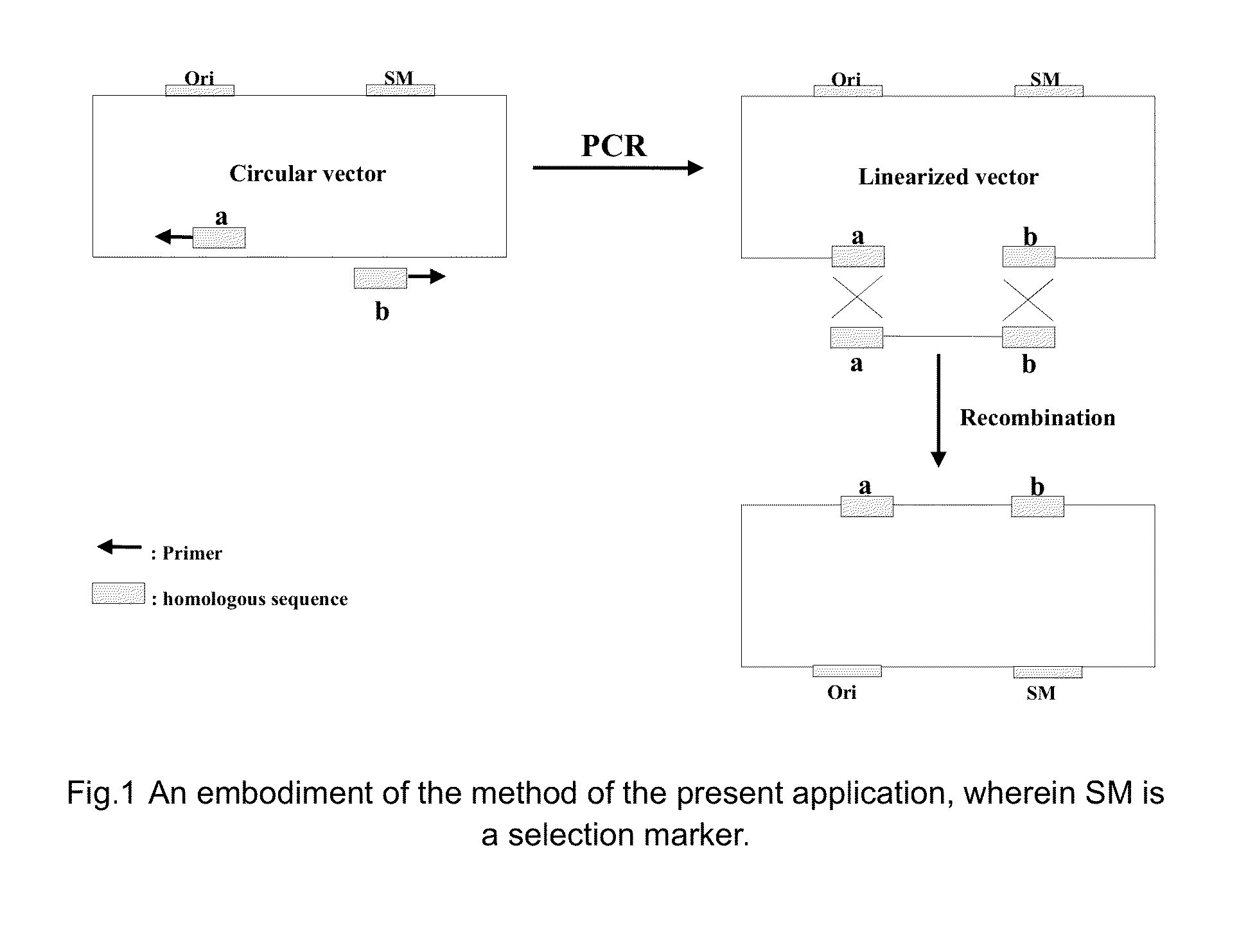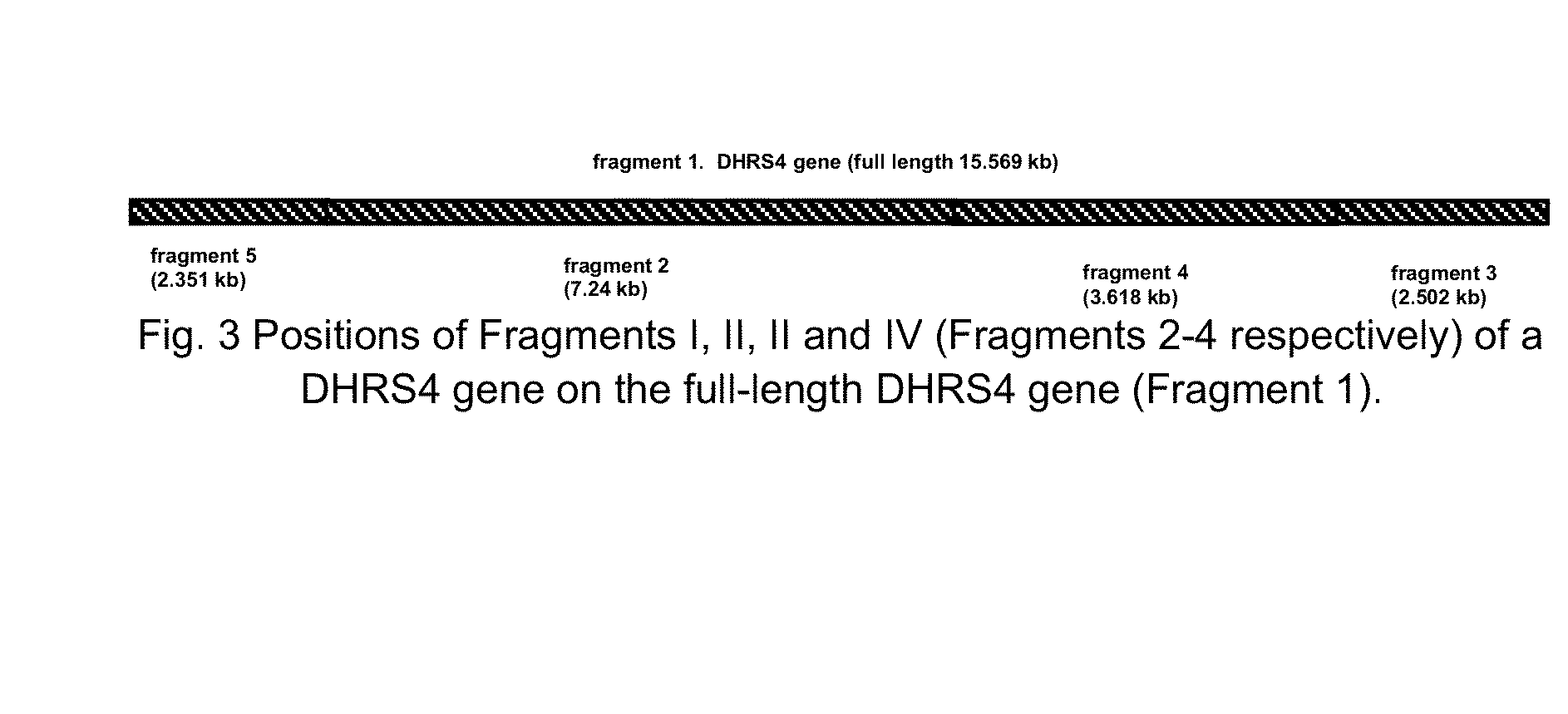Homologous recombination-based nucleic acid molecular cloning method and related kit
a nucleic acid molecular cloning and homologous recombination technology, applied in the field of dna recombination, can solve the problems of low cloning efficiency, tedious and time-consuming conventional cloning methods, and existing homologous recombination-based cloning methods
- Summary
- Abstract
- Description
- Claims
- Application Information
AI Technical Summary
Benefits of technology
Problems solved by technology
Method used
Image
Examples
example 1
[0092]The human DHRS4 gene cluster has three copies of genes, which are DHRS4 (15.569 kb), DHRS4L2 (about 35 kb) and DHRS4L1 (also called DHRS4X), respectively, wherein the former two have very high (90% to 98%) homology, and pertain to segmental duplication. The homology between DHRS4L1 and DHRS4 and between DHRS4L1 and DHRS4L2 are 77.8% and 77.7%, respectively. High homology between the three genes limits the application of conventional molecular biology methods, and produces difficulty for the sequencing of the DHRS4 gene (15.569 kb in full length), i.e., it is difficult to carry out accurate sequencing of the gene and the SNP studies through the new-generation gene sequencing technology and the gene chip trapping technology (from Agilent and Nalgene companies).
[0093]This example mainly used an enzyme mixture containing RecE and RecT to homologously recombine the DHRS4 gene into a p15A vector (Biovector (Beijing) Co., Ltd.). Briefly, the 15-50 bp sequences at both sides of the DH...
example 2
[0099]According to the method described in Example 1, suitable PCR primers were designed to clone a murine TFIIA gene (transcription factor IIA) with a length of about 30 kb from plasmid LAWRIST7-mTFIIA (Gene Bridges GmbH) to the p15A vector. The PCR product of the plasmid resulted from positive clones was verified by the PstI restriction map. FIG. 4 provides a restriction map of the PCR product resulted from partially positive clones therein. As can be seen from the FIG. 5, Lanes 2 to 13 in FIG. B were normal ligations, while Lane 14 was non-proper ligation. Statistics show that the rate of successful ligation (the number of the clones that were correctly ligated / the number of the detected positive clones) in accordance with the cloning method of the present application was 65% to 70% or so.
example 3
[0100]The method of Example 1 was used to clone the target DNA molecules with differing sizes into the vectors. Each group of the rates of correct cloning in Table 1 below were the rates of correct cloning (i.e., rates of successful ligation) verified by restriction detection (a restriction map of the PstI enzyme).
TABLE 1Sizes of thetarget DNA1 kb3 kb5 kb10 kb30 kbNumbers of clones436615340279185(amounts of coatedbacteria in 100 μL)Rates of correct9 / 108 / 108 / 106 / 107 / 10cloning
PUM
| Property | Measurement | Unit |
|---|---|---|
| Density | aaaaa | aaaaa |
| Density | aaaaa | aaaaa |
Abstract
Description
Claims
Application Information
 Login to View More
Login to View More - R&D
- Intellectual Property
- Life Sciences
- Materials
- Tech Scout
- Unparalleled Data Quality
- Higher Quality Content
- 60% Fewer Hallucinations
Browse by: Latest US Patents, China's latest patents, Technical Efficacy Thesaurus, Application Domain, Technology Topic, Popular Technical Reports.
© 2025 PatSnap. All rights reserved.Legal|Privacy policy|Modern Slavery Act Transparency Statement|Sitemap|About US| Contact US: help@patsnap.com



